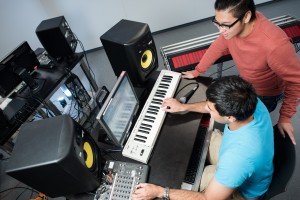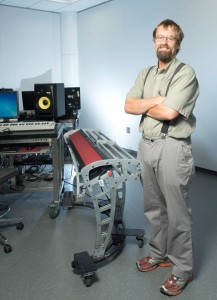Building Campaign Navigation

Recent Posts
- ECE ILLINOIS dedicates two sculptures at new building
- Donor wall celebrates leadership donors to the Building Campaign for ECE ILLINOIS
- Robotics Laboratory prepares students for the future
- A revamped Digital Signals Lab
- ECE Building grounds’ history with Illinois
- Generating improved power labs
- Low donation funds classroom wing
- Introducing the Open Projects Lab
- $1 million gift makes Srivastava Senior Design Lab possible
THE BUILDING CAMPAIGN FOR ECE ILLINOIS
ECE Building includes state-of-the-art music lab
In the new ECE building, a specially designed lab space gives students an opportunity to develop as both engineers and musicians.
The new music lab, located in 3024 ECE Building, is more than double the size of the previous space in Everitt Lab.
Lippold Haken, an ECE lecturer, is excited that ECE 402, Electronic Music Synthesis, has two lab stations for students to work on instead of one. Now, the class is set up in a room that is acoustically isolated from the rest of the building. The upgrade creates an environment that is much more conducive to the music making process than what was previously available.
“In Everitt Lab, we had a small room that we had retrofitted with acoustic carpet on the wall, and we could only put one station in there,” Haken said.
Students now have the opportunity to schedule more convenient times in the lab. At Everitt, there was an issue of students having to schedule after midnight in order to secure lab time, but the new space has created much more availability for students.
Lab time is a crucial aspect of the class because it gives students the opportunity to actually work with the sound equipment. All of the equipment found in the lab stations is also used in the movie and gaming industries.
“Sound design can mean a lot of different things,” Haken said. “In a lot of cases, the sound designer is a person who selects the best sounding recording and mixes it in. It can also mean something much more extreme like when a sound designer creates new sound algorithms.”
The devices in the music lab are meant to challenge students. Haken hopes students walk away from the class with greater understanding that engineering isn’t always about finding ways to make things easy. Creating music with a synthesizer should be a challenging process that requires a lot of time and effort, just like creating music with an acoustic instrument.
“Engineers have worked really hard to make musicians’ jobs easier,” Haken said. “This has worked to an extent, but it’s also had the negative effect of deskilling people. It has made it almost so easy that you can replace the musicians with a synthesizer. At that point, you also lose something. You have to be pretty hard of hearing to not be able to tell the difference between an orchestra and synthesizer.”
Since joining the class, junior Molly Pace has enjoyed the opportunity to explore her musical interests, and said that the lab time has really helped her solidify its concepts. She decided to take the class after she saw Haken do a demonstration in ECE 110 of one of the most innovative items in the music lab: the Continuum Fingerboard.
Haken invented the Continuum Fingerboard and said that many students are attracted to the class because of the opportunity to work with the instrument. While students won’t have enough time to master the instrument, they will get a chance to experiment with it.
ECE 402 currently has about 60 students each semester, which makes it one of the largest technical classes of its type in the world. However, Haken would like to build a larger culture around the new music lab and develop students toward becoming even more passionate about the music they create.
“I want to attract even more students who will spend time with the art,” Haken said. “It’s hard for students to have free time, but to actually pursue art is something that I think is very important in modern society.”




